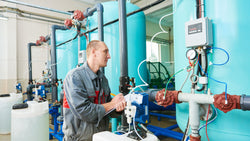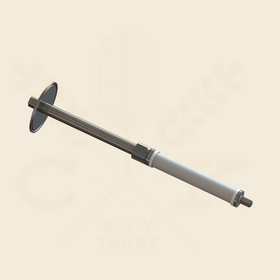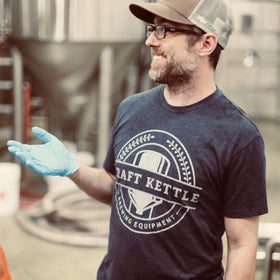The Significance of Preventative Maintenance in a Craft Brewery

Introduction
Maintaining a craft brewery's regular production flow can be all-consuming, with each day dedicated to specific tasks. As an owner and brewer, it's easy for preventative maintenance to fall by the wayside. However, some maintenance tasks cannot wait and require immediate attention.
The Importance of Preventative Maintenance
Late fall to winter, when sales typically slow down, provides an ideal opportunity to address specific preventative maintenance tasks. For those who prioritize cleanliness and organization, these tasks are often quick and painless. However, if you tend to be less organized, some of these tasks may seem like a daunting nightmare.
Regardless, maintenance in a brewery is inevitable. The distinction lies in whether it's proactive or reactive maintenance, which often reflects the workplace habits. It's time to show appreciation to your hardworking equipment by donning your personal protective equipment (PPE) and playing some good music. Let's explore some common and noteworthy areas of preventative maintenance in breweries.
Pumps: The Heart of the Brewery
Pumps, often referred to as the heart of the brewery, are responsible for directing liquid from one vessel to another. When these vital organs malfunction, many brewery operations come to a standstill. Centrifugal pumps are the most commonly used models in the industry.
Replacing Pump Seal Kits
Brewers often encounter the need to replace centrifugal pump seal kits when unexpected leaks occur, often on days they hoped would be easy. Pump usage varies considerably between breweries in terms of schedules, times, and liquid temperatures. Consequently, it is challenging to establish a strict seal replacement timeline. However, by understanding the frequency of pump usage in your operation, you can establish a reliable schedule.
Disassembling and Replacing Pump Components
Most centrifugal pumps in breweries utilize gaskets, O-rings, and carbon seal components to maintain a hygienic and leak-free seal. Over time, these components wear down and need replacement. Disassembly involves removing the outer clamp and the pump head. Pump manufacturers usually provide labeled and detailed pictures for guidance. Pay attention to the pump shaft, as some models have movable shafts that may slide out of place due to heavy use. If necessary, adjust the shaft to ensure a tight seal and proper positioning of internal components.
Maintaining Spare Seal Kits
While some breweries can afford to wait for pump leaks or until they notice strange noises during operation, others with tight schedules cannot tolerate such unexpected disruptions. Regardless of the category your brewery falls into, maintaining a time log of pump servicing dates, including seal replacements, is a wise decision. Additionally, it's beneficial for breweries to keep multiple spare seal kits on hand to address unforeseen emergencies.
Caring for Stainless Steel (SS) Equipment
Another crucial preventative maintenance task that should be a top priority for every brewer is caring for stainless steel (SS) equipment. When treated properly, SS vessels and parts can last a lifetime. Periodic passivation cycles help maintain the protective coating that SS is known for.
Understanding Passivation in Brewing
Passivation in brewing refers to the process of chemically treating stainless steel to create an invisible, protective layer or coating. This layer reduces the susceptibility of the metal to corrosion and pitting caused by cleaning chemicals, carbon dioxide (CO2), and beer. Cleaning the SS equipment is the first step in the passivation process, ensuring the removal of organic and inorganic compounds.
Proper Passivation Procedures
For specific passivation instructions, it is recommended to consult with your chemical supplier. The Birko Corporation, a well-known chemical supplier in the industry, provides detailed passivation information and instructions in their document "Protecting Your Stainless Steel."
Maintaining Air Compressors
Breweries often rely on air compressors for various operational needs. According to The Brewers Association's published Sustainability Manuals, poorly maintained air compressors can lead to excessive energy consumption. Therefore, it's essential to schedule maintenance time for your compressor.
Routine Checks for Air Compressors
Consulting your specific compressor model's manual is the most effective way to identify the areas that require attention. However, as a general guideline, the following checks should be conducted periodically: ensuring the compressor is firmly bolted to the floor, draining excess moisture from the tank, inspecting compressor hoses for air leaks, examining the air filter, and changing the oil and oil filter if necessary.
Other Maintenance Areas in Breweries
In addition to the mentioned tasks, there are several other preventative maintenance processes that are important in breweries:
-
Cleaning and Maintaining Draft Systems: Regularly cleaning and maintaining draft systems is crucial to ensure the quality and flavor of the beer served. This includes cleaning beer lines, faucets, and keg couplers, as well as checking for any leaks or issues in the system.
-
Temperature Control and Calibration: Temperature control is vital in breweries to maintain consistency and quality during fermentation and storage. Regularly calibrating temperature controllers, thermometers, and temperature probes ensures accurate readings and helps prevent temperature fluctuations that could affect the beer.
-
Regular Inspection of Hoses and Fittings: Hoses and fittings are commonly used in various processes throughout the brewery. Regularly inspecting them for wear, leaks, or damage and promptly replacing or repairing them helps prevent unexpected issues during operations.
-
Cleaning and Maintenance of Cooling Systems: Cooling systems, such as chillers and glycol systems, play a critical role in maintaining proper fermentation and storage temperatures. Regular cleaning, checking coolant levels, and inspecting components like pumps and heat exchangers help ensure the efficient and reliable operation of these systems.
-
Maintenance of Electrical Systems: Electrical systems power various equipment and machinery in breweries. Regular inspection of electrical connections, wiring, and control panels helps identify and address any potential hazards or malfunctions to ensure the safety and proper functioning of the brewery.
-
Regular Calibration and Maintenance of Testing Equipment: Testing equipment, such as pH meters, dissolved oxygen meters, and hydrometers, provide essential data for quality control. Regular calibration and maintenance of these instruments ensure accurate measurements and reliable data for brewing processes.
-
Cleaning and Sanitizing Fermentation and Conditioning Tanks: Proper cleaning and sanitization of fermentation and conditioning tanks are essential to prevent contamination and off-flavors in the beer. Regular cleaning routines and adherence to proper sanitization protocols help maintain a hygienic brewing environment.
Conclusion
By prioritizing preventative maintenance in your craft brewery, you can avoid costly downtime, prolong the lifespan of your equipment, and ensure smooth and efficient operations. Take the time to care for your equipment, and it will reward you with consistent performance and exceptional quality.




